https://www.youtube.com/watch?v=5o8Vdn0LeGo
How to solve a 4x4x4 Rubik's Cube (1_3)
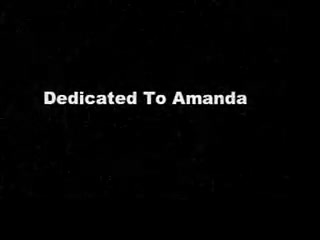
For over 25 years , the world has lived in .
Needless fear , fear of a small plastic cube that can twist and turn into all sorts of demented combinations .
Fear that the world would never be able to contort this six sided multicolored beast into the orderly form .
It once in June 2007 , as these fears were about to reach a breaking point .
A young hero from Nebraska was able to show the world the light and to teach the masses how to tame their three by three by three creatures .

The world is now at peace but trouble seems to be brewing greater still are the challenges that lie ahead and the world will soon need their hero .
The Rubik's company has created a larger beast that is far more unruly and unpredictable than its predecessor .
And the world has turned to their hero for an encore .
The cube is back and it wants revenge before you can solve one of these .
You're going to have to have knowledge of how to solve one of these .
Also in order to best utilize this video , I highly recommend that you watch it with paper and a pen .
You're gonna want to take a lot of notes .
Also , I recommend that you have a pointer finger so that you can click the pause button whenever you find it necessary .
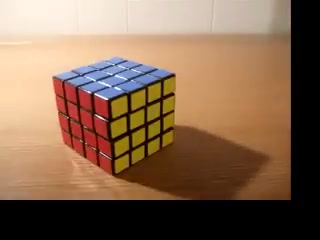
Having all of these things will make your four by four by four .
Rubik's cube solving experience go much more smoothly .
All right , let's get the easy stuff out of the way .
One slight difference between four by four by four notation and three by three by three notation is that when we want to go counter clockwise on the four by four by four cube , while it may still be called front inverted or left inverted or right inverted or up inverted .
Instead of being noted by a lower case I , it will be noted by an apostrophe or a prime symbol .
Uh That's simply because lower case letters represent something different in the four by four cube , which we'll get to in just a minute on the four by four by four , Rubik's cube , there are some extra inside wedges that you don't have to worry about on a three by three by three , Rubik's cube .
The way that we notate these wedges is instead of using capital letters , we use lower case letters .
Let me give you some examples .
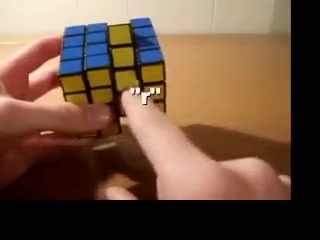
This wedge that's out of place would be a lower case R .
This wedge that's out of place would be a lower case D this wedge that's out of place would be a lower case L and this wedge that's out of place would be a lower case U .
So in short , these inside wedges are notated with the same letters as they're corresponding outside wedges , except instead of being capital letters , they are notated with lower case letters .
The way that you know , clockwise or counterclockwise is still exactly the same .
A little F regular would look like that where a little F prime would look like that , you just do it to the inside wedge instead of the outside wedge .
All right , two more things , any capital letter that then has a star after it means that not only do you do the outer wedge , but you also do the inner wedge .
For example , an F star would look like that an R star would look like that .
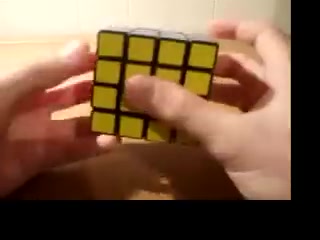
And ad star would look like that .
Anything with A two in front of it means that you do what you would normally do except twice .
For example , a two F would look like that .
And whenever you do something twice , it doesn't matter which direction you go .
So you'll never have a two F prime .
For example , because the prime makes no difference .
If you have a two R star means you do that fairly simple .
Sounds complicated , but it isn't .
So at this point , you're probably feeling pretty comfortable with the four by four by four Rubik's cube standard notation , but you haven't probably put a whole lot of thought into how you're gonna be solving it and you very well may be shaking in your boots a little bit scared and reasonably .
So , I mean , look at this thing , this thing is a beast .
This thing will eat you for dinner or breakfast .
But don't worry , I'm gonna show you right now basically what we're gonna be doing on a three by three by three cube .
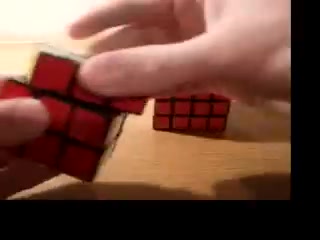
You know what each side is because you know , the centerpiece , the center can never change .
If you use standard notation on a four by four by four cube , you don't have a centerpiece .
So you don't know which side is which .
So the first step is you solve the centers , then what you're going to do is you're going to group little two by one blocks like this together to form and to function as though they were one piece .
Once you get all these together , basically you have a scrambled three by three cube and you can mostly solve it like that .
Then there's a little thing called parody .
Uh We'll get into that once we have to , but that's the basic outline of how you solve a four by four by four cube .
Are you looking for a way to reach a wider audience and get more views on your videos?
Our innovative video to text transcribing service can help you do just that.
We provide accurate transcriptions of your videos along with visual content that will help you attract new viewers and keep them engaged. Plus, our data analytics and ad campaign tools can help you monetize your content and maximize your revenue.
Let's partner up and take your video content to the next level!
Contact us today to learn more.